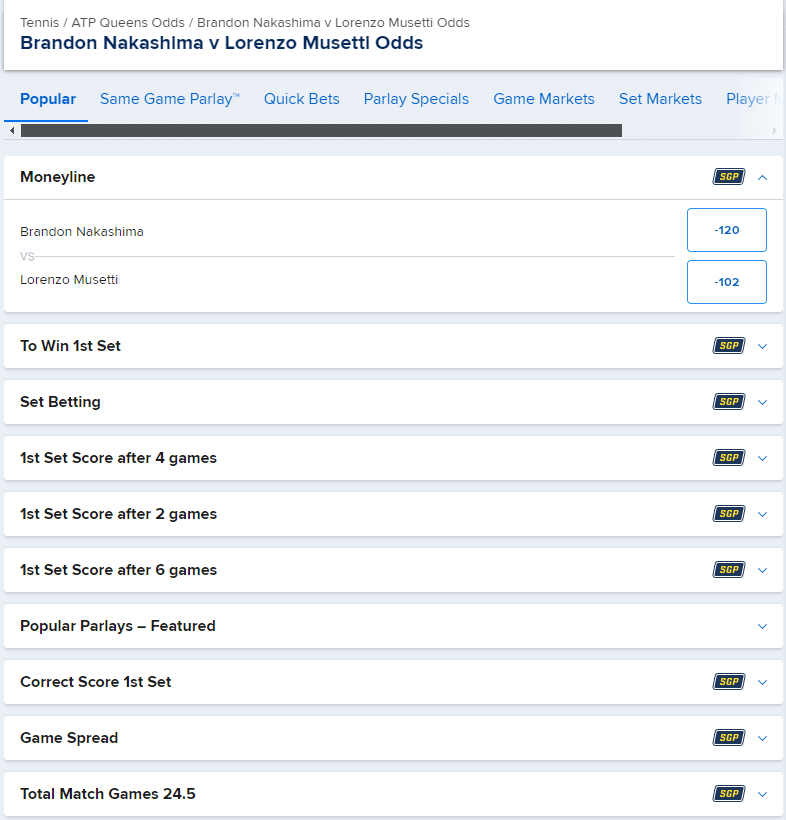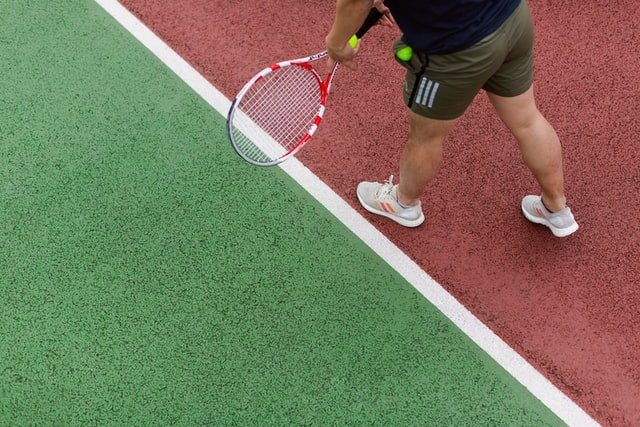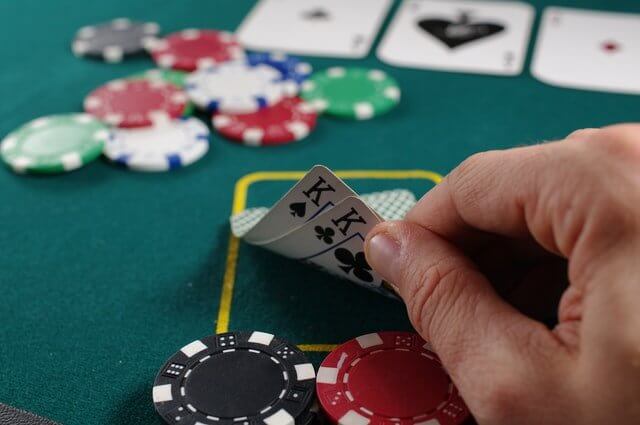Tennis is a sport played almost year-round, with only a short break between seasons, and savvy bettors can find value at a variety of levels regularly. It is ideal for building parlays with small odds, especially during the first and second rounds of tournaments where top players often compete against qualifiers.
If you’re curious about how to bet on tennis, you’re in the right place. Betting on tennis has unique aspects, but don’t worry – we’ll guide you through everything you need to know before you start wagering.
The Most Common Types of Tennis Bets
In tennis betting, the most prevalent wager is backing a specific player in the moneyline market, predicting the match winner outright. These moneyline selections are often included in parlay bets, where multiple picks are combined into one wager. However, some moneyline odds can be highly restrictive, particularly for heavily favored players such as Novak Djokovic at -700.

Alternative betting options cater to those seeking different strategies beyond backing overwhelming favorites. These include:
- Game Spread
- Set Spread
- Over/Under
- Futures
- Props
Game Spread
With many matches appearing to be one-sided contests, the point spread will help even the playing field. These odds will give the underdog a fighting chance, while it will also offer the favorite a handicap to overcome. This is the ideal market when a top 10 player is drawn against a wildcard competitor.
For example:
| Player | Game Spread | Odds |
| Stefanos Tsitsipas | +5.5 | -375 |
| Carlos Alcaraz | -5.5 | +240 |
Your picks include a wager on Tsitsipas at +5.5 on the game spread. He must stay within five games of Alcaraz to cash in.
If Greek is defeated 6-4, 6-4, this would be classed as a winning wager as he has managed to amass eight games. If you add the +5.5 to this amount, it produces 13.5 (which is higher than 12).
Set Spread
The set spread is often more popular at Grand Slam events, particularly in five-set contests. Once again, the underdog is given a chance on the spread market (usually +1.5 sets), while the favorite is given a handicap to overcome (usually -1.5 sets).
Here is another example:
| Player | Set Spread | Odds |
| Novak Djokovic | -1.5 | -200 |
| Frances Tiafoe | +1.5 | +420 |
In this case, if you bet on Tiafoe, you will win if he wins at least one set against Djokovic. If you’re backing a player to win -2.5 sets on the set spread, they must win 3-0 for this to pay out.
Over/Under
This type of bet is ideal for parlay backers and allows tennis bettors to make a prediction without having to pick a winner.
Bettors will be able to wager on the total number of games played in a match. Ideal contests for this market are matches in which the two players are either extremely closely matched or both in good form.
The majority of ATP and WTA tour matches will have the over/under market set at between 19.5 and 22.5, with this total rising for five-set contests at Grand Slams.
| Player | Over/Under | Odds |
| Jannik Sinner | Over 21.5 | -110 |
| Andrey Rublev | Under 21.5 | +180 |
In this example, if you bet on a match to have over 21.5 games, the match must include at least 22 games. So, if Sinner and Rublev play two sets, the player who loses the match must win at least 10 games. This would make the score 7-6, 6-4, which is the minimum required for your bet to win. Although this can be tricky, you can consider this bet when you believe there’s a high chance the players will go to a third set.
Futures
These lines are always very popular ahead of Grand Slam events, and most reputable online sportsbooks will have plenty of pre-tournament betting lines available each year.
These are likely to include “Player A to Win their Quarter” or “Player B to Reach the Semi-Finals.”
Futures betting lines are sometimes available for other WTA and ATP tournaments, although the majority of bettors will tend to stick to the four major events on the tennis calendar.
| Tennis player | Odds to Win Australian Open |
| Novak Djokovic | +175 |
| Carlos Alcaraz | +225 |
| Jannik Sinner | +250 |
| Daniil Medvedev | +750 |
| Alexander Zverev | +1000 |
Props
There are a number of lines available for each match, and these afford the opportunity for tennis bettors to be a little more specific with their picks. Examples include a Tiebreak in the Match, Total Games Won by Player A, and the Second Set Correct Score.
Here are some examples of the prop bets:
| Match | Tennis Props | Bet 1 | Bet 2 |
| Novak Djokovic vs. Carlos Alcaraz | At least one tie-break | Yes (-110) | No (-110) |
| Jannik Sinner vs. Daniil Medvedev | Total aces 10.5 | Over (-110) | Under (+210) |
| Iga Świątek vs. Aryna Sabalenka | To Break Serve First | Świątek (-150) | Sabalenka (+220) |
| Coco Gauff vs. Jessica Pegula | Double Faults 3.5 | Over (-130) | Under (+130) |
Live Tennis Betting
One of the most popular ways of wagering is by utilizing live tennis odds. Most online sportsbooks will now provide live in-play tennis markets, which tend to be available throughout the majority of the match. The live betting section of the website tends to be clearly signposted at the top of the home page.
Every single point could help potentially change the direction of the match, and the fluctuating live tennis odds will reflect this. Just one break of serve can significantly change the prices of each player, and this can be extremely rewarding for those who can anticipate these sudden match swings. Live odds can change incredibly quickly in fast-paced contests.
You can still wager on the over/under market and various other lines once the match has begun, although bets tend to take a couple of additional seconds to process due to the ever-changing nature of a live sporting event.

Waiting For a Favorite
Many savvy tennis bettors wait until a favorite is in a losing position before getting involved. This usually produces more favorable lines than the pre-match markets.
Most online sportsbooks will also offer some sort of cash-out service that will allow you to take a portion of your winnings even if your parlay selections have yet to conclude. You can check on the progress of your matches by using the live in-play section of the website at any point.
Live in-play wagering on tennis is an extremely exciting way to follow all of the action, although, with the constantly changing lines, it may take some getting used to. We strongly advise to practice by watching a tennis match using the live in-play section of the site prior to making any picks.
Tennis Betting Tips
Tennis betting odds can be extremely volatile, especially in matches that have already got underway. Therefore, it’s vitally important to adhere to a number of rules.
Specialize
It’s important to focus on a specific area when it comes to wagering on tennis. On busy days, there can be 100-plus matches taking place, and this can make it incredibly tough to follow. If you’re able to narrow it down to a specific level, region, or individual player, this will make it much easier to make your picks.
Likewise, focus on specific markets. If your expertise lies in the over/under markets, then make sure you aren’t tempted to deviate and start browsing other lines.
Don’t Wager for the Sake of It
There will be some days (particularly November/December) when there are fewer matches taking place. This can often make it difficult to find value picks. If this is the case, it is advised to simply wait until something more tempting comes along.
You don’t have to bet every single day, and you don’t have to wager simply because there are tennis matches taking place.
Local Players Tend to Prevail at the Lower-Ranked Events
In ITF events, local players will be invited to compete, and they tend to fare well at these types of events. Although the seeded players have far more quality overall, the weather conditions, the partisan crowd, and their local knowledge can come in extremely handy. It is important to ensure that you don’t overlook these types of players in your picks.
Look for Players Coming Back from Injury
Sometimes, a player can make their return following an injury layoff, and this can often result in the tennis betting odds being skewed towards the opposition player. Players will not come straight back into competitive action without practice, although it can be hard to get back up to speed immediately.
When the likes of Stan Wawrinka and Kei Nishikori returned from a break, they were still clear favorites in the tennis betting odds. However, they weren’t match-fit and therefore struggled to remain competitive.
Understanding Player Approaches
Finally, it’s important to understand how each player approaches a match. Some competitors prefer to stick to the baseline and rely on their opponents to make unforced errors. Others will prefer to go for the jugular and attack their rival from the first serve.
If you use the stats to establish the type of match that may unfold, then this will help improve your picks long-term.
Major Tennis Events in 2025
There are four Grand Slam events on the ATP and WTA calendar, and these are scheduled throughout the season.
| 🎾Event | 📋 Details |
| Australian Open | 🌎 Melbourne; 📅 January 2025 |
| Roland Garros (Paris, May/June 2025) | 🌎 Paris; 📅 May/June 2025 |
| Wimbledon | 🌎 London; 📅 June/July 2025 |
| US Open | 🌎 New York; 📅 August/September 2025 |
| ATP/WTA Finals | 🌎 Turin/Riyadh; 📅 November 2025 |
The Australian Open takes place in mid-January and is competed on the hard courts in Melbourne. The French Open is the second Grand Slam of the season and takes place at the end of May. It is the only one of the four majors on clay courts.
This is closely followed by Wimbledon with the grass-court action taking center stage in London. Finally, the US Open gets underway at the end of September and takes place at Flushing Meadows in New York.
These events attract extremely high-quality fields, and sportsbooks always offer additional lines on the four Grand Slams. The men play five-set matches at each of these tournaments, and that enables the opportunity for more twists and turns. This is ideal for in-play betting enthusiasts.
Grand Slam tournaments always attract a high-quality field, and five-set matches can negatively impact those players who are forced to endure a quick turnaround at these events.
ATP / WTA Events

Outside of the four Grand Slam events, players on the ATP and WTA tours play competitive tennis on a regular basis. Events take place around the world on a variety of different surfaces, and each player will win points based on their performances in these competitions.
Online sportsbooks provide odds for each of these tournaments, and they are extremely popular with bettors. Events are classified according to their quality with ATP 1000 events such as Indian Wells and the Monte-Carlo Masters always extremely popular with parlay and props bettors.
These events will get additional coverage from the sportsbooks and tend to attract a high percentage of top-10 competitors.
Best Tennis Betting Sites: Analysis by the US Bookies Team
Our team at US Bookies researched five major online sportsbooks in the U.S.: DraftKings, FanDuel, BetMGM, Caesars, and bet365. All of these platforms offer comprehensive coverage of major tournament matches, making them solid choices for basic bets.
However, if you’re looking for something more specific, our findings show that DraftKings offers the highest moneyline odds, while bet365, FanDuel and BetMGM excel in providing a wide variety of matches and tournaments. Additionally, bet365 is also the top choice for those seeking diverse wager options.
| 📊 Category | 🥇 Top Sportsbook | 🥈 Alternative Choice |
| Highest Moneyline Odds | DraftKings | FanDuel, Caesars |
| Variety of Matches | bet365 | FanDuel, BetMGM |
| Variety of Wagers | bet365 | FanDuel |
Tennis Betting Glossary
Here, you can find some of the expressions that refer to tennis betting.
- Break of Serve: Betting on whether a player will break their opponent’s serve in a particular game.
- Clay Courts: Slower surface that affects ball speed and bounce, favoring baseline players.
- Grass Courts: Faster surface with low bounce, favoring serve-and-volley players.
- Hard Courts: Medium-speed surface that provides a balanced playing field.
- H2H: Historical performance of players against each other.
- Matchup: Analysis of how players’ styles and skills compare.
- Tie-Break: Played to settle a set that reaches 6-6.
- Walkover: Occurs when a player moves on to the next round without playing.
More Sports:

How and where you can bet on football games

How to wager on your favorite basketball events

Learn baseball wagering from our experts

Online soccer betting is another thing you can bet
Tennis FAQs
Tennis betting involves placing wagers on various outcomes of tennis matches, such as match winners, set scores, game totals, and more. Bettors can place bets before a match (pre-match) or during a match (live betting).
The most common tennis bets include:
- Match winner (moneyline);
- Set betting (predicting the exact set scores);
- Game spread (handicap betting on games);
- Over/under (betting on the total number of games or sets).
A set spread involves betting on the margin of victory in sets (e.g., Djokovic -1.5 sets means they must win by at least 2 sets). Game spread is similar, focusing on the margin of victory in games within a set.
Over/under betting in tennis involves predicting whether the total number of games or sets played in a match will be higher (over) or lower (under) than a specified number set by the sportsbook. A total games over 21.5 in tennis means at least 22 games must be played, such as a 7-5, 6-4 scoreline.
Live-betting (or in-play betting) allows bettors to place wagers on tennis matches while they are in progress. Odds and betting options can change dynamically based on match events such as scores, game outcomes, and player performance.





